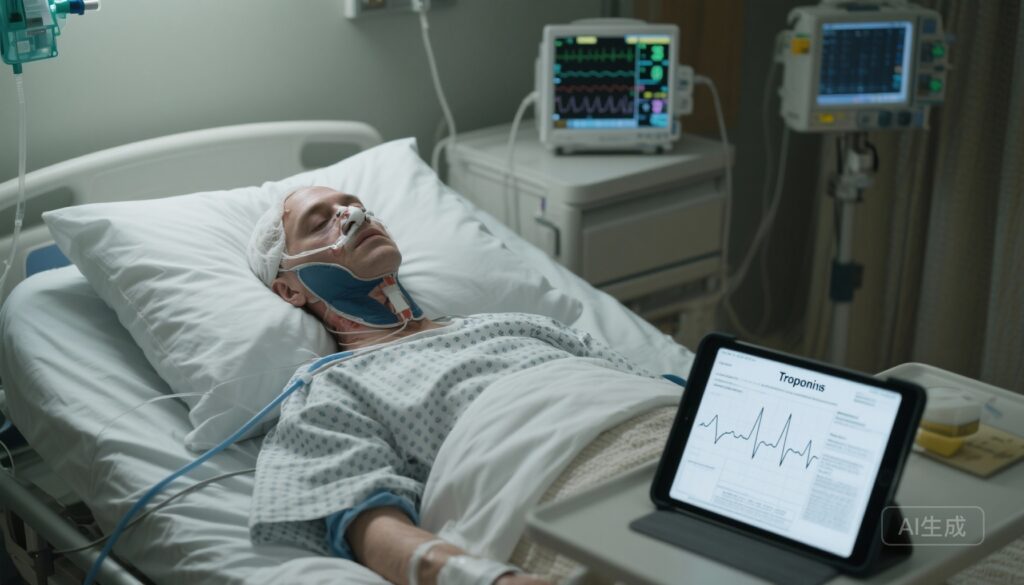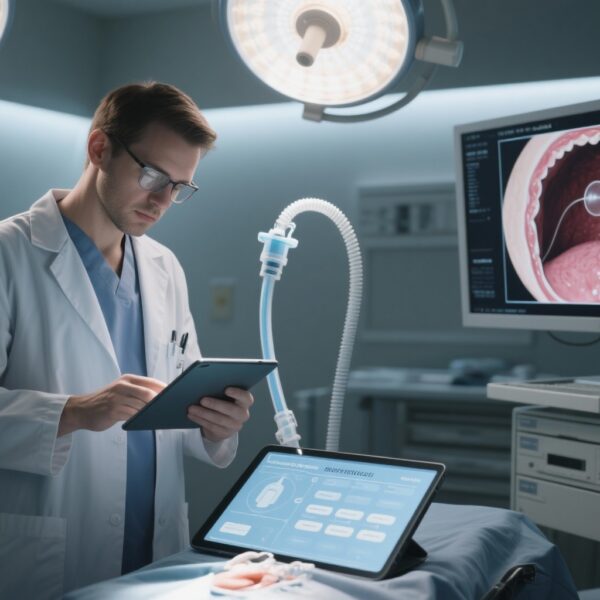Highlights
– Myocardial injury after noncardiac surgery (MINS) occurred in 11.9% of patients undergoing major head and neck surgery in a VISION cohort subanalysis; incidence rose to 23.8% among patients aged ≥75 years.
– Nearly 69% of MINS events would have been clinically silent and undetected without routine troponin T monitoring in the first three postoperative days.
– MINS was independently associated with a marked increase in 30‑day mortality (HR 5.51) and, when accompanied by ischemic features, with prolonged length of hospital stay.
Background: Clinical context and unmet need
Perioperative myocardial injury—detected as an elevation in cardiac troponin after noncardiac surgery—has emerged as a frequent and prognostically important complication. The term myocardial injury after noncardiac surgery (MINS) captures troponin elevations presumed to be ischemic in origin and has been shown in mixed surgical cohorts to associate with short‑term mortality. Head and neck surgical procedures are heterogeneous but often involve long operative times, significant fluid shifts, airway manipulation, and frequent comorbid illness in an older population. Despite these factors, there has been uncertainty about the incidence and prognostic impact of MINS in the major head and neck surgery population, and whether routine troponin monitoring could meaningfully identify high‑risk patients who would otherwise be missed by symptom surveillance alone.
Study design
The report by Staibano et al. (JAMA Otolaryngol Head Neck Surg. 2025) is a cohort analysis nested within the international VISION (Vascular Events In Noncardiac Surgery Patients Cohort Evaluation) study. VISION prospectively enrolled a large, heterogeneous sample of adults undergoing noncardiac surgery and included routine perioperative troponin surveillance in many centers. The current analysis identified the subset of 648 patients who underwent major head and neck surgery requiring at least a 1‑day postoperative admission and had troponin T (TnT) measured during the first three postoperative days.
MINS was defined according to assay-specific thresholds: for high‑sensitivity TnT (fifth‑generation assays), a value of 20–64 ng/L with an absolute change >5 ng/L or ≥65 ng/L, accompanied by evidence of cardiac ischemia; for fourth‑generation assays, a non‑hsTnT ≥0.04 ng/mL plus ischemia. Analyses considered the incidence of MINS, the proportion of events that would have been clinically undetected without troponin monitoring, and associations between MINS and 30‑day mortality and length of hospital stay (LOHS), using Cox regression and multivariable linear models, respectively.
Key findings
Incidence and patient characteristics
– Overall incidence of MINS in this major head and neck surgery cohort was 11.9% (95% CI, 9.39%–14.4%).
– Incidence increased steeply with age: 23.8% (95% CI, 15.7%–32.0%) in patients aged 75 years or older.
– MINS occurred more often in patients with preexisting medical comorbidities (the authors report higher prevalence of cardiovascular disease and other risk factors among those with MINS).
Detection and clinical silence
– A striking 68.8% (95% CI, 57.3%–78.9%) of MINS cases would have gone undetected without routine postoperative TnT monitoring, indicating that most events were clinically silent—no ischemic symptoms prompting testing.
Outcome associations
– Thirty‑day mortality in the whole cohort was 1.9% (95% CI, 0.8%–2.9%); one‑year mortality was 13.1% (95% CI, 10.5%–15.7%).
– MINS was associated with substantially increased 30‑day mortality (hazard ratio [HR] 5.51; 95% CI, 1.75–17.36), an effect size consistent with prior literature indicating that even subclinical troponin elevations carry meaningful short‑term risk.
– Length of hospital stay was prolonged in patients with MINS who had at least one ischemic feature (adjusted β 3.15 days; 95% CI, 1.47–6.76 days), suggesting clinical consequence beyond mortality—resource use and recovery are affected.
Interpretation of effect sizes
Although the absolute 30‑day mortality was low in the cohort, the relative increase associated with MINS was large. The confidence interval around the HR is wide, reflecting a limited number of deaths, but the lower bound remains clinically important. The magnitude of LOHS prolongation suggests MINS has tangible downstream effects on postoperative recovery and hospital resource utilization.
Expert commentary and clinical implications
The study reinforces three practical points:
1) MINS is not restricted to traditional high‑cardiac‑risk surgeries. Even in head and neck procedures—often perceived as primarily surgical and airway‑focused—perioperative myocardial injury is common, especially in older and comorbid patients.
2) Reliance on symptoms alone misses most MINS. The high proportion of clinically silent events argues for routine surveillance if the clinical aim is to identify perioperative myocardial injury.
3) Identification of MINS identifies patients at substantially higher short‑term mortality risk and increased hospital stay. This presents an opportunity for targeted secondary prevention (e.g., optimization of hemodynamics, antiplatelet strategies when appropriate, statin therapy, and early cardiology involvement) but also raises questions about whether detection and subsequent interventions improve outcomes—this remains unproven in randomized trials.
Where this might influence practice
Clinicians caring for older patients and those with cardiac risk factors undergoing major head and neck surgery should consider perioperative risk stratification that incorporates the possibility of MINS. At centers where troponin monitoring is feasible, routine postoperative troponin measurement during the first 48–72 hours will detect additional patients at risk. However, detection alone creates a management imperative—clinicians must have pathways to evaluate for ischemia, rule out alternate causes of troponin elevation, and initiate evidence‑based secondary prevention. Until trials demonstrate that troponin‑guided management reduces adverse outcomes, practice should integrate clinical judgment, patient values, and institutional capacity.
Mechanistic plausibility
Perioperative myocardial injury is thought to arise from supply–demand mismatch (type 2 ischemia) attributable to hypotension, tachycardia, anemia, hypoxia, or from plaque instability and thrombosis (type 1 ischemia) precipitated by inflammatory and prothrombotic perioperative states. Major head and neck surgery can involve prolonged hypotension, blood loss, and stress responses—mechanisms compatible with myocardial injury. The predominance of clinically silent troponin elevations suggests many events are subclinical ischemia rather than overt myocardial infarction, but both carry prognostic significance.
Limitations of the study
– Observational design: Causality cannot be inferred. MINS may be a marker of illness severity rather than a direct cause of death in some patients.
– Event counts: The number of deaths was small, producing wide confidence intervals for mortality estimates; results should be interpreted as hypothesis‑generating.
– Heterogeneity of troponin assays and thresholds: The study combined assay generations and used assay‑specific definitions; while pragmatic, this introduces complexity for generalizing thresholds across institutions.
– Management after detection was not standardized: The study reports associations but cannot determine whether specific interventions following troponin detection changed outcomes.
– Generalizability: The cohort reflects patients from centers participating in VISION and may not capture all practice settings or the full range of head and neck procedures (e.g., outpatient or minor cases excluded).
Research and policy implications
Key unanswered questions include whether routine postoperative troponin screening followed by a standardized management bundle reduces mortality and morbidity after major head and neck surgery. A pragmatic randomized trial of troponin surveillance with protocolized post‑detection care versus usual care would be the definitive test. Meanwhile, consensus pathways that define which patients to monitor, diagnostic steps after a positive troponin, and evidence‑based therapeutic options (antiplatelet/antithrombotic strategies, statin initiation, and hemodynamic optimization) would help translate detection into potential benefit while avoiding unnecessary interventions.
Conclusion
The VISION cohort subanalysis reported by Staibano et al. demonstrates that myocardial injury after major head and neck surgery is common and clinically important: it is frequently clinically silent, is associated with a markedly increased short‑term mortality risk, and prolongs hospitalization when accompanied by ischemic features. These findings argue for heightened perioperative cardiovascular vigilance in this surgical population, especially among older and comorbid patients. However, routine troponin screening should be implemented with caution and preferably within pathways that specify follow‑up evaluation and management, until randomized data establish that detection and treatment improve outcomes.
Funding and ClinicalTrials.gov
For details of funding sources, conflict of interest disclosures, and trial registration for the parent VISION study, refer to Staibano P et al., JAMA Otolaryngol Head Neck Surg. 2025.
Selected references
1. Staibano P, Garg AX, Chan MTV, et al. Myocardial Injury After Major Head and Neck Surgery. JAMA Otolaryngol Head Neck Surg. 2025;151(7):647‑654. doi:10.1001/jamaoto.2025.0656.
2. Thygesen K, Alpert JS, Jaffe AS, et al. Fourth Universal Definition of Myocardial Infarction (2018). J Am Coll Cardiol. 2018;72(18):2231‑2264.
3. Kristensen SD, Knuuti J, Saraste A, et al. 2014 ESC/ESA Guidelines on non‑cardiac surgery: cardiovascular assessment and management. Eur Heart J. 2014;35(35):2383‑2431.
AI image thumbnail prompt
Realistic hospital scene: a middle‑aged to elderly patient recovering after head and neck surgery in a hospital bed, a clinician reviewing a tablet displaying a troponin lab result and ECG tracing, subdued clinical lighting, focus on the tablet screen and concerned but professional expressions, photographic realism.



